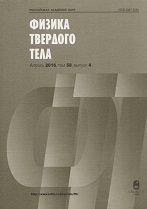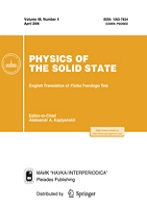|
Semiconductors
Pathways of transitions between polytypes in silicon carbide
S. A. Kukushkinabc, A. V. Osipovb
a Institute of Problems of Mechanical Engineering, Russian Academy of Sciences, St. Petersburg
b St. Petersburg National Research University of Information Technologies, Mechanics and Optics
c Peter the Great St. Petersburg Polytechnic University
Abstract:
In this work, two main polytypic transformations in silicon carbide, namely, 2H→6H and 3C→6H, were studied using ab initio methods. It is shown that intermediate states with trigonal symmetry P3m1 and monoclinic symmetry Cm greatly simplify the movement of close-packed layers during such transitions, breaking them up into separate stages. It was found that the two polytypic transformations occur quite differently. During the 2H→6H transition, the displaceable bonds are noticeably tilted compared to the initial position, which makes it possible to reduce the compression of SiC bonds in the (11ˉ20) plane. The 3C→6H transition takes place through the formation of auxiliary Si–Si and C–C bonds that live for a short time and help the tightly packed layers exchange places. As a result, the activation barrier for the conversion of 2H→6H (1.7 eV/atom) is significantly less than the activation barrier for the conversion of 3C→6H (3.6 eV/atom), which means that the second transition must occur at temperatures of 750–800∘ higher than the first one. The energy profiles of these polytypic transformations, as well as the geometry of all intermediate and transitional phases, are calculated. It is shown that all transition states have monoclinic symmetry.
Keywords:
phase transitions, polytypes, silicon carbide, method of nudged elastic band, method of density functional.
Received: 10.04.2019
Revised: 11.04.2019
Accepted: 11.04.2019
Citation:
S. A. Kukushkin, A. V. Osipov, “Pathways of transitions between polytypes in silicon carbide”, Fizika Tverdogo Tela, 61:8 (2019), 1443–1447; Phys. Solid State, 61:8 (2019), 1389–1393
Linking options:
https://www.mathnet.ru/eng/ftt8722 https://www.mathnet.ru/eng/ftt/v61/i8/p1443
|


| Statistics & downloads: |
| Abstract page: | 113 | | Full-text PDF : | 39 |
|





 Contact us:
Contact us: Terms of Use
Terms of Use
 Registration to the website
Registration to the website Logotypes
Logotypes









 Citation in format
Citation in format 